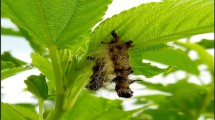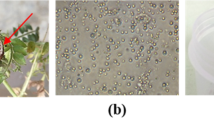Abstract
India has a rich biodiversity of microbes. Soil is the major source for isolation of entomopathogens, after the infected insects themselves. Four isolates of Helicoverpa armigera nuclear polyhedrosis virus (HearNPV) were obtained from the samples collected one each from Anand, Surat and Junagadh of Gujarat and Patancheru of Andhra Pradesh. All the HearNPV isolates appeared as clear, irregular six-sided objects with rounded edges, phase-bright under phase contrast. Junagadh, Surat, Patancheru and Anand isolates gave 27.47–42.80%, 36.83–51.32%, 26.05–43.76% and 42.99–54.85% mortality, respectively, when the percent mortality was pooled over period. The least number of HearNPV polyhedral inclusion bodies (PIBs) (5.1 × 107) of the Anand isolate were required to kill 50% of the H. armigera population within 120 h. The Anand isolate was fastest (90.30 h), followed by Surat (120.26 h), Junagadh (139.53 h) and Patancheru (143.10 h) in killing 50% of the H. armigera population at a dose of 109 PIBs ml−1. RAPD analysis of all 15 arbitrary oligonucleotide primers generated 353 scorable bands with 201 loci. A total of 181 polymorphic bands were obtained, ranging in size from 141 to 1,873 base pairs. The percentage of polymorphic loci was 90.19%. The mean polymorphism information content (PIC) value for 15 primers was found to be 0.99. The similarity coefficient values based on 15 RAPD markers ranged from 0.235 to 0.407. The four isolates were grouped into two clusters: one cluster consisted of Junagadh and Anand and the second cluster consisted of Surat and Patancheru.

Similar content being viewed by others
References
Adams, J. R., & McClintock, J. T. (1991). Nuclear polyhedrosis viruses of insects. In J. R. Adams & J. R. Bonami (Eds.), Atlas of invertebrate viruses (pp. 87–204). Boca Raton, FL, USA: CRC Press.
Barreto, M. R., Guimaraes, C. T., Teixeira, F. F., Paiva, E., & Valicente, F. H. (2005). Effect of Baculovirus spodoptera isolates in Spodoptera frugiperda (J.E. Smith) (Lepidoptera: Noctuidae) larvae and their characterization by RAPD. Neotropical Entomology, 34(1), 67–75.
Cory, J. S., Green, B. M., Paul, R. K., & Hunter-Fujita, F. (2005). Genotypic and phenotypic diversity of a baculovirus population within an individual insect host. Journal of Invertebrate Pathology, 89, 101–111.
Finney, D. J. (1971). Probit analysis (3rd ed.). London, UK: Cambridge University Press.
Getting, R. R., & McCarthy, W. J. (1982). Genotypic variation among wild isolates of Heliothis spp. nuclear polyhedrosis viruses from different geographical regions. Virology, 47, 245–252.
Gomez, K. A., & Gomez, A. A. (1984). Statistical procedures for agricultural research. New York, NY: Wiley InterScience.
Jaccard, P. (1908). Nouvelles recherches sur la distribution florale. Bulletin de la Societe Vaudoise des Sciences Naturelles, 44, 223–270.
Jones, K. A. (2000). Bioassays of entomopathogenic viruses. In A. Navon & K. R. S. Ascher (Eds.), Bioassays of entomopathogenic microbes and nematodes (pp. 95–140). Wallingford, UK: CAB International.
Ma, X., Xu, H., Tang, M., Xiao, Q., Hong, J., & Zhang, C. (2006). Morphological, phylogenetic and biological characteristics of Ectropis obliqua single-nucleocapsid nucleopolyhedrovirus. The Journal of Microbiology, 44, 77–82.
Malla, P. (1992). The insecticidal crystal protein Cry IA(c) from Bacillus thuringiensis is highly toxic for Heliothis armigera. Journal of Invertebrate Pathology, 59, 109–111.
Mcintosh, A. H., Grasela, J. J., & Goodman, C. L. (2005). A simplified and rapid method for extraction of DNA from baculovirus occlusion bodies. Resource document: www.bioprocessingjournal.com. Accessed 4 January 2007.
Odak, S. C., Srivastava, D. K., Mishra, V. K., & Nema, K. K. (1982). Preliminary studies on the pathogenicity of Bacillus thuringiensis and nuclear polyhedrosis virus on Heliothis armigera host in the laboratory and pot experiment. Legumes Research, 5, 13–17.
Ogembo, J. G., Kunjeku, E. C., & Sithanantham, S. (2005). A preliminary study on the pathogenicity of two isolates of nucleopolyhedroviruses infecting African bollworm, Helicoverpa armigera (Lepidoptera: Noctuidae). International Journal of Tropical Insect Science, 25, 218–222.
Ogembo, J. G., Chaeychomsri, S., Kamiya, K., Ishikawa, H., Katou, Y., Ikeda, M., et al. (2007). Cloning and comparative characterization of nucleopolyhedroviruses isolated from African bollworm, Helicoverpa armigera (Lepidoptera: Noctudiae), in different geographic regions. Journal of Insect Biotechnology and Sericology, 76, 39–49.
Rabindra, R. J., Ethiraju, S., & Jayaraj, S. (1991). Efficacy of nuclear polyhedrosis virus formulations against Heliothis armigera (Hüb.) sunflower. Journal of Biological Control, 4, 130–131.
Steel, R. G. D., & Torrie, J. H. (1980). Principles and procedures of statistics: A biometrical approach (2nd ed.). New Delhi, India: McGraw-Hill Koga-Kusha.
Sudhakar, S., & Mathavan, S. (1999). Electron microscopical studies and restriction analysis of Helicoverpa armigera nucleopolyhedrosis virus. Journal of Biology, 24, 361–370.
Teakle, R. E., Jensen, J. M., & Giles, J. G. (1985). Susceptibility of Heliothis armigera to commercial nuclear polyhedrosis virus. Journal of Invertebrate Pathology, 46, 166–173.
Vasiljevic, L., & Injac, M. (1973). A study of gypsy moth viruses originating from different geographical regions. Plant Protection, 24, 169–186.
WeiDe, S., Bing, L., Ping, J., & LiHua, L. (2003). RAPD analysis of nuclear polyhedrosis virus (NPV) from Bombyx mandarina, Bombyx mori and Antheraea pernyi. Acta Sericologica Sinica, 29, 148–150.
Zhang, C. X., Ma, X. C., & Guo, Z. J. (2005). Comparison of the complete genome sequence between C1 and G4 isolates of the Helicoverpa armigera single-nucleocapsid nucleopolyhedrovirus. Virology, 333, 190–199.
Author information
Authors and Affiliations
Corresponding author
Rights and permissions
About this article
Cite this article
Patel, C.S., Jani, J.J., Parekh, V.B. et al. Genetic diversity and differentiation of Helicoverpa armigera nuclear polyhedrosis virus isolates from India. Phytoparasitica 37, 407–413 (2009). https://doi.org/10.1007/s12600-009-0060-5
Received:
Accepted:
Published:
Issue Date:
DOI: https://doi.org/10.1007/s12600-009-0060-5




